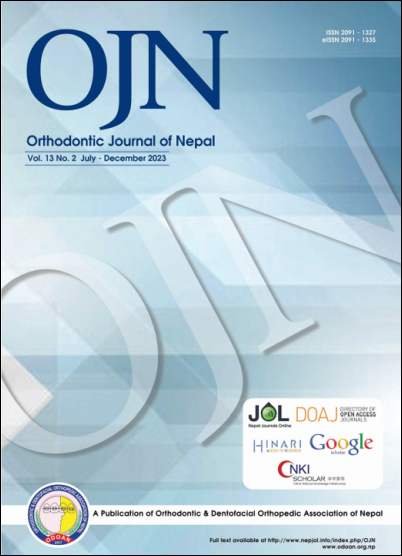An evaluation of inter-relationship between cervical posture and skeletal malocclusions
DOI:
https://doi.org/10.3126/ojn.v13i2.54195Keywords:
Craniocervical posture, Head posture, Rotation of mandibular ramusAbstract
Introduction: The growth pattern of the cervical spine and the craniocervical structure are interconnected, inflencing one another both morphologically and functionally. As a result, stretching the head in relation to the cervical spine leads to notable changes, including greater anterior facial height, a shorter sagittal dimension, and a posterior rotation of the jaw. This study was conducted to determine the correlation between cervical curvature in different sagittal skeletal malocclusions and association between cervical lordosis and maxillary and mandibular base.
Materials and Method: One hundred fity adults presenting with skeletal Class I, II, and III malocclusion were investigated, irrespective of growth pattern. Three groups were delineated based on the lateral cephalograms of the selected participants: Group 1 (50 skeletal Class I), Group 2 (50 skeletal Class II), and Group 3 (50 skeletal Class III). A comprehensive assessment of cervical posture was conducted through the measurement of manually traced 15 specifi angles, which were carefully chosen to provide a detailed characterization of cervical variations across all three groups. Validity was assessed using Wilk and Kolmogorov-Smirnov tests, and analysis was done using One way Analysis of variance and Post hoc Turkey’s test.
Result: Statistically signifiant correlations (P<.05) were found between angles OPT/HOR and CVT/HOR (representing cervical inclination with reference to the true horizontal plane),NSL/CVT, and FH/CVT (indicating middle craniocervical posture), NSL/RL, FH/RL, and NL/RL(reflcting rotation of mandibular ramus).
Conclusion: It was proven that changes in head posture and craniofacial development are strongly correlated. The rotation of the mandibular ramus in relation to the cranium was compared between groups, and was found that skeletal Class II malocclusion subjects had more posterior rotation of the ramus in relation to the cranium and extended head compared to those with skeletal Class III and skeletal Class I malocclusion subjects.
Downloads
Downloads
Published
How to Cite
Issue
Section
License
Copyright (c) 2024 Orthodontic & Dentofacial Orthopedic Association of Nepal

This work is licensed under a Creative Commons Attribution 4.0 International License.
Copyright © held by Orthodontic & Dentofacial Orthopedic Association of Nepal
- Copyright on any research article is transferred in full to the Orthodontic & Dentofacial Orthopedic Association of Nepal upon publication in the journal. The copyright transfer includes the right to reproduce and distribute the article in any form of reproduction (printing, electronic media or any other form).
- Articles in the Orthodontic Journal of Nepal are Open Access articles published under the Creative Commons CC BY License (https://creativecommons.org/licenses/by/4.0/)
- This license permits use, distribution and reproduction in any medium, provided the original work is properly cited.




